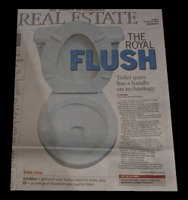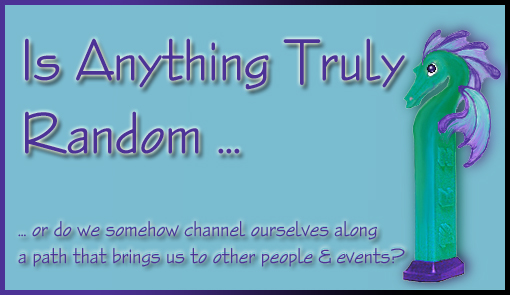Flush

We've been having flushing issues for a while now - our front yard was dug up last year for sewer line work. I still use the plunger frequently ~ but that's due to a particular person residing in this household that uses too much paper and not enough flushing.
You can imagine the conversations around here.
Also imagine my delight at this article in Sunday's Patriot News:
The Orange County Register
YORBA LINDA - It wasn't enough for John Koeller to flush gummy bears down the toilet.
No. In the name of science, he had to flush oatmeal and sausages and Cheerios and Play-Doh and toy water-wigglers before settling on the substance he now flushes with such gusto that he and his partner have become Canada's largest importer.
Put down your bagel. Stop eating. For the next few minutes, we're going to talk about ... soybean paste.
Not the soybean paste you eat in miso soup (though it's the very same stuff.) But the soybean paste that industrial engineer Koeller - aka the "Toilet Guru" - of Yorba Linda uses to routinely test some 200 models of low-flow toilets. All so the sound you hear next time you flush won't be that of money going down the drain. What he does exactly with this paste would make any seventh-grade boy bray with delight. It should do the same for you - if you're a homeowner. Because, for all the razzing he takes as the toilet guru, Koeller, 67, knows how to save you money. And embarrassment. And he's happy to tell you. If you're willing to listen. Important dates in toilet history: 1596 - Toilet invented. 1775 - S-trap invented. 1872 - Flush tank invented. It took another 120 years for the first step backward in toilet technology. It came when Congress enacted the Energy Policy Act of 1992, requiring all new toilets to flush 1.6 gallons of water rather than the standard 3.5 gallons. "There was a terrible consumer backlash and a protest against low-flow fixtures," says Mary Ann Dickinson, executive director of the California Urban Water Conservation Council in Sacramento. Why? The plumbing industry was unprepared, and their new toilets really didn't work. Customers kicked and screamed. They complained to their congressmen. And worse, in terms of water conservation: they double-flushed and rejiggered their low-flows to flush more water. The trouble was too few standards. In those days, all a toilet maker had to do pass certification was flush 75 out of 100 three-quarter-inch plastic balls. "John figured out this test was meaningless," says Dickinson, "and that unless we devised a test that actually simulated what we flush down the toilet, we couldn't accurately test the performance of these low-flow fixtures." This led Koeller and his Canadian cohort, Bill Gauley, to start flushing gummy bears and oatmeal down their test toilets in Toronto. In purely technical terms, these things are called "media." As in, If we don't find something to solve this problem, the media is really going to hit the fan! Once Koeller and Gauley found the right media (from a Japanese exporter who was so horrified to learn where his miso was going that he made the men sign an agreement to never utter the word in their reports), they did what engineers have long done. They researched - first and foremost, how much media ought a good toilet be able to flush. Without going into gory detail, let us just say it's 250 grams (about a half-pound). Then in 2003, the men went where no one had gone before: They tested every brand of low-flush toilet they could find to see exactly how good each was at flushing their new media. For that, Dickinson says, "He's a great unsung hero in the water conservation world. He's been in Newsweek, Time, the Wall Street Journal, all the construction magazines and energy magazines. He's known internationally." No one said being a hero was easy. Leastwise, not in the toilet world. "I am the toilet guru," Koeller admits. "You bring that up at a party and you never live it down. I brought up urinals once and never heard end of it. When people ask now, I say I'm a lint broker to the movie stars!" His study - called Maximum Performance Testing of Popular Toilet Models, or "MaP" for short, raised more than a few snickers. It virtually turned the toilet industry on its head. Now in its fifth edition, it compares 177 low-flow toilet models (the sixth edition, due in January, will compare about 200). And here's the rub: "We've learned, in a number of studies, that there is no correlation between price and performance," Koeller says. "That's right. Some of the cheapest toilets are some of the best performers." The reason: until recently, consumers had no way of knowing which toilets performed best, so price was set mostly by style. When Koeller and Gauley began their tests, it was the water districts - in the name of conservation - who funded them. Just three years later, it is the toilet manufacturers themselves promoting the tests. Dickinson says it's likely the MaP test will become part of a new, nationwide standard (for now, the 75-ball standard remains in effect). In fact, she's helping the U.S. Environmental Protection Agency create a nationwide water-efficiency organization, named the Alliance for Water Efficiency, which will promote MaP testing. "There's no point being efficient if the customer has to run the water longer or double flush," she says. All of which brings us to: What kind of toilet should you buy? It depends, says Koeller, whose back yard is crammed with new models for testing, but whose bathroom sports a Toto Ultra Max (MaP score: 700 grams!). There is gravity-feed vs. power-assist (power-assist typically flushes more but is louder). There is two-piece vs. one-piece (one-piece typically looks sleeker but is pricier). There are variations of bowl shape, seat height, even doohickeys like heated seats, slam-resistant seats and dual-flush mechanisms, featuring a half-flush of 0.8 gallon for liquid-only flushing. Those factors depend on preference. Flushing power is all about function. But buyer beware! Just because a manufacturer makes one or several powerful models doesn't mean all of its models are powerful. It pays to compare. Visit: www.cuwcc.org/MaPTesting.lasso for test results. (Note: prices not included, so you'll have to do some homework yourself.) The good news, says Koeller (who, by the way, is not connected to the Kohler toilet company), is that new manufacturers have made competition fierce. "Prices aren't much higher than 12 years ago," he says. "Yet I'd say 75 percent are excellent." Thanks in large part to ... soybean paste. In the meantime, Koeller is leading the charge on another new trend in water conservation. He's already started writing national standards. For what? Nothing that will require gummy bears or oatmeal or even more soybeans. A waterless urinal.




8 Comments:
250 grams, ey? Now that is making a number ;)
Interesting to learn when the toilet had been invented and how other parts of it were added on later.
Lots of information here! Yep. A subject folks don't talk about, but an object each and every one of us uses daily. Even the Queen.
Good gravy! You and Aral are both having toilet/bathroom issues right now, huh? I remember when Someone Who Will Remain Nameless decided to flush papertowels down the toilet. $300 later, we were unclogged once more.
I keep thinking about Doug's story and the toilet issues that also go with matches. At least you haven't had any of those problems, 3D.
Such good information here! I'm sure I can work this into a conversation somehow. I'll be the hit of the party. :)
Come to think of it, the toilet was a wonderful invention. Well done, whoever you are that invented it.
That was a really funny and well-written piece. I remember the sewer sage from last year. Maybe you should feed the unnamed person soybean paste.
Makes sense to me. Soybean paste is brown, isn't it?
Waterless urinal is fine, as long as they don't do away with those pretty pink cakes that they put in the bowl. Those things look good enough to eat.
I think about the water my old toilet uses. For a while, I kept a 2 liter coca-cola bottle filled with pebbles and water in the toilet tank, to make it use less water. But that did not work very well. There was much double flushing.
Maybe one day I will get a pisser in the throne room. Those things use as little as a pint of water per movement. But it is only good for liquids.
Post a Comment
<< Home